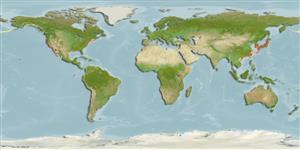Themiste pyroides (Chamberlin, 1920)
| Native range | All suitable habitat | Point map | Year 2050 |

|
| This map was computer-generated and has not yet been reviewed. |
| Themiste pyroides AquaMaps Data sources: GBIF OBIS |
Upload your photos
Google image |
No photo available for this species.No drawings available for Golfingiidae.
Google image |
No photo available for this species.
Classification / Names Common names | Synonyms | CoL | ITIS | WoRMS
Not assigned | Sipuncula | Golfingiidae
Environment: milieu / climate zone / depth range / distribution range Ecology
Benthic; depth range 0 - 36 m (Ref. 1815). Temperate
Distribution Countries | FAO areas | Ecosystems | Occurrences | Introductions
Western Central Atlantic and the Pacific Ocean: Alaska, Japan, Mexico and USA.
Length at first maturity / Size / Weight / Age
Maturity: Lm ? range ? - ? cm
Short description Morphology
Large animals, brownish-yellow to dark brown in color. Body 0.1-0.6 mm long. Trunk spindle shaped or cylindrical. Introvert significantly longer than trunk. Body surface smooth-seeming, as papillae covering it very small. Cephalon bearing dendritic crown of tentacles, consisting of 6 main dichotomic branching trunks. Number of orders of branching characteristic
of every particular specimen (from 4-7). Branches of tentacles bearing pinnules with
purple pigmented grains. Smooth collar behind tentacles, tentacles,
with violet patchy pigmentation. Zone of irregularly arranged large scalids behind cephalon. Longitudinal musculature of body wall not divided into longitudinal bands, instead forming solid layer. 2 retractors of introvert, both ventral and fastened into posterior third of trunk. Contractile vessel with long, filiform, spirally twisted branches braiding internal organs. Gut long, comprising 16-20 loops. 3 fixing muscles. Anal opening level with nephridiopores. Wing
muscles well-developed. No rectal diverticulum found. 2 nephridia partially fastened to body wall by mesenterial filaments. Nephridia 80% as long as trunk region (Ref. 1815).
At intertidal depths in crevices and spaces under rocks (Ref. 1840). Among rhizomes of Phyllospadix iwatensis and clusters of Modiolus modiolus kurilensis on rocky grounds (Ref. 1815).
Life cycle and mating behavior Maturity | Reproduction | Spawning | Eggs | Fecundity | Larvae
Main reference
References | Coordinator | Collaborators
Morozov, T.B. and A.V. Adrianov. 2002. (Ref. 1815)
IUCN Red List Status (Ref. 130435: Version 2024-1)
CITES status (Ref. 108899)
Not Evaluated
CMS (Ref. 116361)
Not Evaluated
Threat to humans
Human uses
| FishSource |
Tools
More information
Trophic Ecology
Food items
Diet
Food consumption
Ration
Predators
Diet
Food consumption
Ration
Predators
Ecology
Population dynamics
Life cycle
Reproduction
Maturity
Fecundity
Spawning
Eggs
Egg development
Larvae
Larval dynamics
Maturity
Fecundity
Spawning
Eggs
Egg development
Larvae
Larval dynamics
Distribution
Human Related
Aquaculture profile
Stamps, Coins Misc.
Stamps, Coins Misc.
Outreach
Taxonomy
References
Internet sources
BHL | BOLD Systems | CISTI | DiscoverLife | FAO(Publication : search) | Fishipedia | GenBank (genome, nucleotide) | GloBI | Gomexsi | Google Books | Google Scholar | Google | PubMed | Tree of Life | Wikipedia (Go, Search) | Zoological Record
Estimates based on models
Preferred temperature
(Ref. 115969): 11.4 - 24.8, mean 22.3 (based on 363 cells).
Price category
(Ref. 80766):
Unknown.


